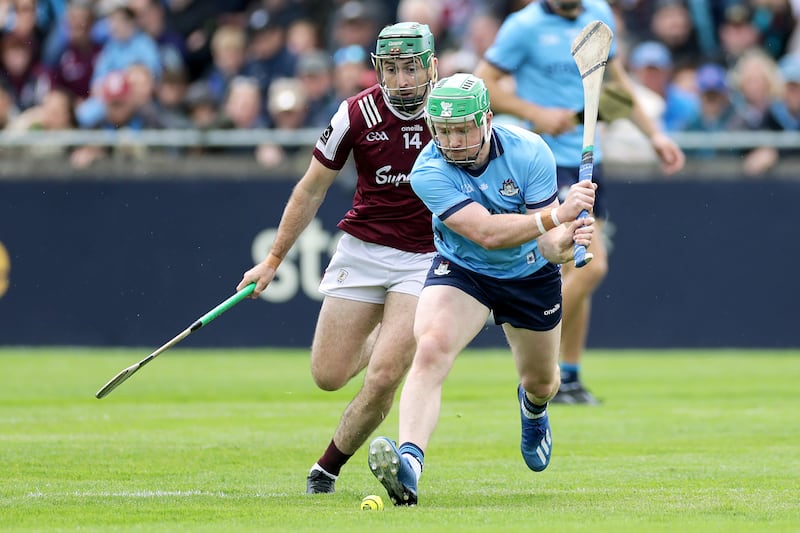In Dublin hurling, things should always be better than they are. Though the playing numbers ebb and flow from year to year, it’s always true that the only county that definitively has more hurlers than Dublin is Cork. There are sometimes more in Tipperary and sometimes less but it’s usually neck and neck. Everybody else is well back the road.
This isn’t to say Dublin should be winning All-Irelands, just that things should be better. More players won’t always translate to success, especially in a county where football consumes so much of the oxygen. But at the very least, they shouldn’t be waiting 12 years between All-Ireland semi-finals. A barren period like that screams of inefficiencies in the system.
The arrival of Niall Ó Ceallacháin has brought about a purge of some of those inefficiencies. Not all of them – and not by a long way – but some. Chief among them has been making sure that anyone who can and should be playing for Dublin right now is playing for Dublin right now.
“Basically, a third of the panel weren’t there last year,” Ó Ceallacháin said ahead of the championship. “We have 35 lads there, that’s what we’re running with. And 12 of them weren’t in there last year, so that’s a good bit of change.”
READ MORE
Dublin actually used 36 players through the league and during the championship they have added Rian McBride, James Madden and Seán Gallagher to the list of those who’ve seen action. Thirty-nine is a hefty enough number – Cork have given game time to 35 this season – and it shows that Ó Ceallacháin was true to his word when he took over. The slate was wiped clean and nothing was ruled out.
Run your thumb through the list of 39 players who have togged out for Dublin in 2025 and their backstories cover the full spectrum of hurling in the capital. So maybe the best way to tell the story of what Dublin hurling is now is to pick three of Ó Ceallacháin’s team and go from there...
The Lifer

It has been a sad week in the Hetherton household. Phyllis Hetherton lived until she was 94 and when she died last Saturday she left behind enough kids, grandkids and great grandkids to fill the terrace in Parnell Park, which is just a stone’s throw from her house in Donnycarney.
On Saturday, in the space of a few hours, two of her grandchildren will play for Dublin against Cork in two different codes. Niamh lines out in an All-Ireland quarter-final for the footballers at lunchtime. And at five o’clock, John will suit up for the hurlers in Croke Park.
Everyone calls John ‘Hedgo’, the same as they called his father Ciarán ‘Hedgo’ when he was a selector under Anthony Daly. John was in his late teens at the time and he got a golden apprenticeship. He travelled everywhere on the team bus, had a backstage pass into the dressingroom, carried hurls and water bottles. Whatever they needed.
If anyone was going to be a Dublin hurler, John Hetherton was going to be a Dublin hurler. He was the free-taker for the county minors, playing in the same side that had Chris Crummey, Danny Sutcliffe and Ciarán Kilkenny. He played under-21 and had a good Fitzgibbon run for the Garda College. But between one thing and another, he was never able to pin down a spot with the Dublin seniors.
He played bits and pieces under Ger Cunningham, Pat Gilroy and Mattie Kenny. But it was mostly Walsh Cup and league. He never started a championship game for any of them and didn’t feature at all under Micheál Donoghue. His last game was in 2021, when he got the last 15 minutes against Clare in the league.
That was presumed to be that. Hetherton was still a totem for Vincents in the club championship but there didn’t seem to be much reason to imagine he could swim back upstream with Dublin. He’d been given every chance to show himself to be an intercounty hurler and it hadn’t worked out. So be it.
Ó Ceallacháin thought different. Hetherton had been immense for Vincents in the 2024 Dublin semi-final against Na Fianna, whipping a late goal to send it to extra-time and potting a sideline ball in extra-time. It was a good time and place to do it – Ó Ceallacháin was in his Na Fianna bib on the sideline and had been appointed Dublin manager just four weeks previously. It can’t have hurt, anyway.
And so it was that at the end of April, at the grand old age of 33 and with his two sons and all the other Hethertons in the stand, John ‘Hedgo’ Hetherton made his first championship start as a Dublin hurler. A fortnight ago, he came off the bench at half-time against Limerick to score one goal and set up another.
Nothing’s over ‘til it’s over.
The New Dublin Hurler

There was never much hurling in Kilbarrack. Go through all your Roddy Doyle books and see if you can find a reference. Flick through old Dublin programmes and you’ll be looking a long time before you find a hurler from that part of the world. The closest hurling stronghold was always O’Tooles and you had to go inland to Coolock for that.
It all changed the way these things always change. In the early 1970s, a local schoolteacher decided the boys in the area needed a GAA club and soon enough a gang of parents helped out. Over time, the schools in Kilbarrack and Bayside started to feed into this new club, Naomh Barróg. They won a couple of Féiles in the 1980s but never really got the put-through they needed at senior level to get out of junior hurling.
But since 2000, Naomh Barróg, like so many other Dublin clubs, have seen the fruits of targeted GAA investment. They have had a full-time Games Promotion Officer since the turn of the century and have been filtering players into Dublin development squads as they go.
One of them is Paddy Doyle, the Dublin wing back. He came through with Dublin North Schools, an amalgamation team made of players from schools from Kilbarrack, Swords, Malahide and beyond. He was in the Dublin development squads at 16, played centre back with the minors in 2020 and corner back with the under-20s for a couple of years as well. As Naomh Barróg made their way to senior, Doyle was one of the key drivers.
It all led to the last week of April 2023, when Doyle played wing back against Antrim, becoming the first Naomh Barróg man to play championship hurling for Dublin. It had taken 49 years but they got there. Three weeks ago, Seán Gallagher became the second when he came on against Kildare. Kilbarrack has hurlers now.
Plenty other places too. The spread of players in the Dublin squad in 2025 is unrecognisable from what it used to be. When Dublin played Cork in the 2013 All-Ireland semi-final, 15 of the 20 players that day were drawn from four clubs – Ballyboden and Cuala alone provided 11 between them.
It’s a much more far-flung operation these days. Against Limerick a fortnight ago, Kilmacud Crokes were the only club to have three players in the starting line-up. Nobody else had more than two. Fingallians had as many players involved on the day as Cuala. Commercials, St Brigids, Clontarf, Lucan, Erins Isle – the Dublin net gathers them in from everywhere now.
The Super-Club Footballer

The biggest contingent is the half-dozen from Na Fianna, the club Ó Ceallacháin led to All-Ireland success earlier this year. In a way, they’re the simplest story in modern Dublin GAA. Based in Glasnevin, with over 4,000 members, fielding somewhere in the region of 220 teams, the numbers game alone should have them riding high. But they were never in a Dublin hurling final before 2021. This is all still very new.
Like so many clubs across Dublin, Na Fianna are a dual enterprise. Kids coming through the age grades play hurling one week, football the next. Which means, of course, that the best footballers are generally high-class hurlers as well. No better example than Conor McHugh.
McHugh played in back-to-back All-Ireland minor hurling finals in 2011 and 2012, back when we all thought that Dublin had got it right and were going to establish themselves as a hurling power. It never happened, partly because football took Ciarán Kilkenny, Cormac Costello and Conor McHugh away.
By 2014, McHugh was the star forward on the greatest under-21 football team of all time. Outshining the likes of Costello, Paul Mannion, Brian Fenton, Niall Scully, Jack McCaffrey, John Small and Davy Byrne, he was man-of-the-match in the All-Ireland final. He joined Jim Gavin’s senior panel the following season and looked like a sure thing.
But despite spending seven seasons with the Dubs, McHugh never started a championship game. In total, he played just 20 matches altogether. There was no mystery to it – the competition was too fierce. He couldn’t force his way in.
He finished up in 2021 and went back playing football and hurling for Na Fianna. McHugh is still a forward in football but his reinvention as a sticky, canny man-marker in hurling has been a revelation. Against Antrim in May, he finally started a championship game for Dublin. A fortnight ago, he started one in Croke Park. Marked Cian Lynch, beat Limerick with 14 men.
Hetherton, Doyle, McHugh. They all found their path to this point, one as unlikely as the next. Each, in their own way, a snapshot of Dublin hurling. Sometimes streamlined, often higgledy-piggledy, rarely adhering to logic. And now just 70 minutes away from an All-Ireland final.
Getting better, despite everything.




















